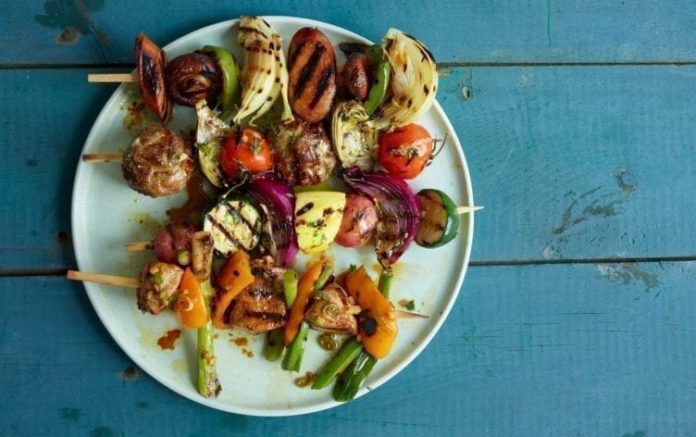
Whether you’re headed for a neighborhood barbecue or cooking out in your own backyard, healthy grilling can seem like a challenge. After all, many traditional staples and sides like burgers and potato salad are covered in high-fat condiments like mayo, and it’s all too easy to graze (and overeat).
At the same time, firing up the grill is the perfect opportunity to bring out the flavor in nutritious, fresh produce and try new spice rubs and marinades. Furthermore, with a few simple tweaks, you can make your favorite grilled eats healthier and tastier.
Here, seven hacks you can use for healthy grilling, according to registered dietitians:
1
CHOOSE LEAN CUTS OF MEAT
When you hit the meat aisle, stock up on selections with a relatively low fat content like flank steak and 90%-lean ground beef, suggests Dana Angelo White, registered dietitian and nutrition consultant based in Fairfield, Connecticut. Ground turkey also makes a tasty choice that’s on the skinny side, adds Hayden James, RD. “A hot dog every now and then is OK, but you might want to watch yourself if they’re a regular in your diet,” says James. Highly processed meats like hot dogs tend to be super high in sodium, which ups your risk for high blood pressure.
2
OPT FOR HEALTHY OILS
Before you load up the grill, brush your veggies with heart-healthy cooking oils like olive oil or avocado oil, which are packed with monounsaturated fats — a healthier option compared to the saturated fats found in butter and coconut oil, says James. “I enjoy grilling with avocado oil because it has a higher smoke point than olive oil, but a similar fruity flavor profile,” she says. Even with healthy fats, though, portion control is key to keep your calories in check. “A single swipe of oil using a pastry brush is plenty to prevent sticking and maintain flavor,” says James.
3
MAKE YOUR OWN MARINADES
When it comes to healthy grilling, you’re better off reducing grill marks and charring on your meat. “Grilling gets a bad reputation for inducing the production of carcinogens known as heterocyclic amines (HCAs) due to the high cooking temperatures,” explains James. “HCAs cause changes in DNA that may increase your risk of cancer.”
The fix is flavorful, though: You can cut the production of nearly 100% of HCAs by mixing black pepper and antioxidant-rich spices (like oregano, basil, thyme and garlic) into your meat, shows a recent study at Kansas State University. “Whisk together some balsamic vinegar or lemon juice with some fresh herbs, olive oil and a drizzle of honey for the perfect marinade,” suggests White. Don’t let your meat marinate for too long, though — after a couple of hours, protective antioxidants can begin to decompose.
4
MIX IN QUALITY CONDIMENTS
“Another barbecue pitfall are all of those creamy sauces. While mayo and sour cream are tasty, they can get you into trouble with high amounts of calories and unhealthy fats,” says White. Here’s what to do: Substitute high-protein, nonfat Greek yogurt for half or all of the mayo or sour cream you typically use in your potato salad, coleslaw and dips, she suggests. For a healthier burger, try swapping your go-to mayo for a slice of avocado, suggests James. “You might not cut many calories, but you will certainly improve the quality of the fat and boost the micronutrient content,” she says. In fact, a review in the Journal of Clinical Lipidology finds making the switch to avocado can help lower your cholesterol levels.
5
EAT YOUR GREENS
Make room on your grill for fresh, seasonal produce like zucchini, yellow squash and summer squashes (which are rich in various B vitamins and vitamin C) for a quick and easy side, says James. “You can spear veggies onto a skewer or make single-serve veggie steaming grill packets,” suggests Amanda A. Kostro Miller, registered dietitian and advisory board member for Smart Healthy Living. To boost their flavor, “just take a squeeze of lemon and add salt, pepper and chopped herbs like parsley, cilantro, mint or chives to drizzle over the squash for a colorful, elevated side,” says James.
6
PUT FRUIT OVER THE FIRE
Making dessert on your grill is easier than you might think: “Peaches, pineapple, watermelon, pears and many other fruits are extra delicious when grilled,” says Kostro Miller. As fruit naturally caramelizes, it makes for a sweet treat that’s lower in fat, calories and sugar than other desserts. Brush on a little cooking oil, skewer a few chunks of fruit or just place fruit slices face-down on the grill.
7
PORTION OUT YOUR PLATE
Use your plate as a visual guide to check your portion sizes, suggests James. Reserve a quarter of your plate for protein (Think: a piece of meat, fish or a veggie burger the size of a deck of cards), at least half of the plate for non-starchy veggies (like coleslaw, broccoli salad and squash) and a quarter for starches (like a whole-grain bun, potato salad or corn on the cob), she suggests. Piling on a half-plate of veggies ensures you’re getting in enough fiber, vitamins, minerals and phytonutrients. If you’re watching your weight, “these vegetables not only provide a delightful and interesting texture and contrast to other foods on the plate, but they are also low in calories,” says James.









